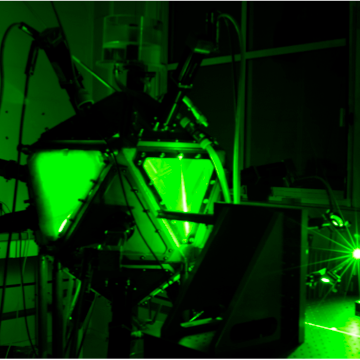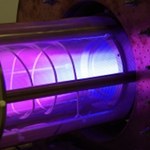Hydrodynamique et Turbulence
 Particle Motion in turbulent flows
Particle Motion in turbulent flows
Romain Volk, Mickaël Bourgoin, Jean-François Pinton
Our group has a well-recognized expertise in the experimental study of particle transport in turbulent flows. In the last decade, we have pionnered a number of innovative techniques to actually follow the motion of various types of particles and has contributed to the description and modeling of finite-size particles dynamics in turbulence. This includes laser-Doppler methods, or methods relying on tracking of particles with several high-speed cameras. These techniques are currently used to study preferential concentration of inertial particles in turbulence, rotation and melting of solid particles, and long time dynamics of very large objects when followed for thousands of large eddy turnover times.
The possibility to follow reliably particle motion in a turbulent flow suggests a new way to investigate turbulence itself: what characterises the motion of one particle transported by the flow? what happens to a small number of particles? The study of the motion of tracer particles leads to a rich phenomenology, and to unexpected properties, such as the intrinsic asymmetry between acceleration and decelerations of particles motion. A related, but different class of project concerns the motion of small, heavy particles in a dilute suspension, for which we are focusing on the rate at which two particles get together (collision rate).
 Magnetohydrodynamics and plasma turbulence
Magnetohydrodynamics and plasma turbulence
Nicolas Plihon, Philippe Odier, Mickaël Bourgoin, Jean-François Pinton
Our team has been involved in turbulent dynamo studies, especially experimentally, using liquid metals over more than 15 years. The von-Karman Sodium collaboration (ENS de Lyon, ENS Paris, CEA Saclay) has demonstrated the existence of turbulent dynamos using liquid sodium. A smaller scale versatile semi-synthetic dynamo has also been developed, which displays several features interesting for the understanding of natural dynamos (terrestrial or stellar dynamos). Thanks to cutting-edge instrumentation, we also have a strong expertise on MHD turbulence. Next generation dynamo experiments will use plasmas as conducting fluids (allowing to reach parameters closer to that of stellar dyanmos). We have developed a plasma-experiment (see photo) where controlled and shaped flows can be driven, allowing for the understanding of momentum coupling to the plasma and momentum and magnetic field transport in turbulent regimes, as weel as the influence of flows on the stability criteria of a magnetized plasma column (drift waves). A first step towards next generation plasma dynamos!
 Thermal convection
Thermal convection
Francesca Chilla, Julien Salort, Louis Couston
Our team has 20 years experience in turbulent thermal convection and our present work are following this direction. We use high Rayleigh model systems as Rayleigh Bernard cell which is essentially controlled by boundary layers and vertical or tilted convective duct connecting larger differentially heated chambers. In the first case boundary layers can be tackled using roughness in the second case the bulk is independent from boundary layers and the flow sustained by a mean gradient. We perform both calorimetric and PIV measurements and we are developing other original technics as back oriented Sclhieren, Mems probes, lagrangians large size probes. We are also developing lagrangian following of particles to characterize the transport and mixing in the whole flow.
 Random fields for fluid turbulence
Random fields for fluid turbulence
Turbulence in fluids have been experimentally studied for a long time. Furthermore, Kolmogorov theoretical works give an additional solid ground to the current understanding and phenomenology of turbulence. In this context, we develop stochastic models for the velocity field able to reproduce the peculiar statistical and geometrical properties of turbulence, which include the physics of scale-invariance and energy transfers.
 Geostrophic turbulence
Geostrophic turbulence
Freddy Bouchet, Antoine Venaille
Geostrophic turbulence refers to strongly rotating and stratified fluids such as the atmosphere or the oceans. These flows have the beautiful property to spontaneously self-organize into large scale coherent structures, and are known to be an important source of intrinsic varability for the climate system. Our themes of research include jet dynamics, multi-stability, models of large scale circulation, loss of balance and vertical energy transfers. We tackle these questions using numerial simulations and a combination of various theoretical approaches, including statistical mechanics, kinetic theory and cascade phenomenology.
 Internal waves and rotating flows
Internal waves and rotating flows
Sylvain Joubaud, Philippe Odier, Antoine Venaille, Thierry Dauxois, Louis Couston
The study of internal waves is of great interest owing to the evolving appreciation of their role in many geophysical systems. In addition to their particularly intriguing properties from a fundamental point of view, these waves play an important role in dissipating barotropic tidal energy in the ocean, transporting momentum in the atmosphere, while their activity also impacts modern-day technology. However, many unanswered questions remain, particularly regarding the fate of internal waves and how much mixing they generate in the ocean and via which processes. We study these questions using several experimental techniques (PIV, Synthetic Schlieren, LIF) while developping also a theoretical understanding. Taking advantage of an innovative new wave generation in stratified fluids, combined with a recently acquired 2-meter rotating table, we tackle different geophysical questions of interests.
 Acoustic spectroscopy of turbulence
Acoustic spectroscopy of turbulence
Antoine Naert
We developed recently a sound spectroscopic technic to probe turbulent flows. It combines scattering and multiple-wave interferometry to achieve an excellent signal to noise ratio. We could evidence a (weak) acoustic dispersion due to turbulent fluctuations.




